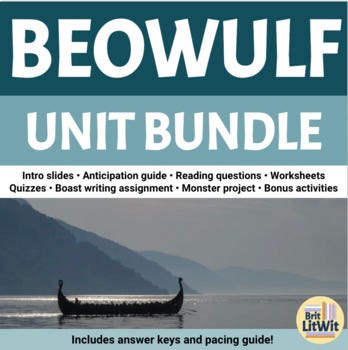How to keep up the energy during your Beowulf unit
Beowulf should be an exciting read in English class (monsters! miracles! boasting in the mead-hall!), but as with any story you turn into a unit of study, there are a bunch of ways you can drive it right on into Blahtown. But you’ve got to get it right: Beowulf is a hyped-up staple of British literature that kicks off the school year for many high school English courses.
Here are my tips for keeping students engaged with the text and making it a meaningful unit:
Tip #1: Keep the historical background brief.
If you’re searching around for Beowulf lesson materials, you’ll notice that there are a lot of handouts about the historical context. The utter volume of it can make it seem like the information is essential to teach. Well, I’m telling you that it’s not. In my early years of teaching I would dutifully inform students about things like the Danelaw, the letters in the Anglo-Saxon alphabet, and wergild, but they didn’t find most of that information interesting and it didn’t help them understand the text better.
Eventually, I distilled the historical information in my introductory slides down to the necessary basics:
How tribes from Scandinavia brought the story to what is now England (which is how it got dropped into the British literature curriculum)
The simple fact that it’s necessary for Beowulf to be translated because Old English is unintelligible to Modern English speakers
That Beowulf represents pre-Christian cultural values (comitatus, wyrd, flyting) with an overlay of a Christian worldview added later
Keep the intro concise so students don’t tune out before you start the text or, later, wonder what was the point of absorbing all that information.
Related resource:
Beowulf Introductory Slides
Tip #2: Allow students to examine the values represented in the text.
A common misstep in teaching Beowulf is turning it into a celebration of “heroic” traits. That approach gets overdone throughout other English courses, and it also tends to result in students completing assignments with ideas they feel like they’re supposed to say, instead of contributing their authentic thoughts.
Students are more engaged with a Beowulf unit and it becomes more rigorous when they have the opportunity to question the cultural values implied in the text. My Beowulf unit starts with an anticipation guide that gets students thinking about what significance social concepts like revenge, loyalty, fame, and competitiveness have in their lives and our society today. Beginning this way frames the Beowulf as a catalyst for meaningful discussions (instead of merely as The First Thing in the British Literature Curriculum).
Related resource:
Beowulf Anticipation Guide
Tip #3: Present the monsters as symbols.
Teenagers, as we all know, can be critical—of themselves, their peers, their parents, their teachers, and also the literature they’re assigned to read (ha). Given the three monster episodes that anchor Beowulf, many students view the text as a simple-minded tale by ancient people who didn’t know any better, thus making them wonder what’s the point of reading it today.
As I thought about how to make Beowulf seem less…silly?, I came up with an approach that helped students recognized the value of the story: viewing the monsters as symbols of real-life catastrophes. After I started framing it that way, students took Beowulf more seriously. Through my “The Reality of Monsters Project,” students were able to identify problems of long ago that might have inspired the character of Grendel, Grendel’s mother, and the dragon. They were eager to analyze the meanings of monsters in recent media and—the best part—develop a monster character that represents a common fear in our own time. This project is one of my favorite teaching resources I’ve ever created. It was always a huge hit with my students and it makes me so happy to hear from so many other teachers who’ve had success with it too. Try it if you’re looking for something to liven up your Beowulf unit!
Related resource:
Beowulf: The Reality of Monsters Project
Tip #4: Use the Seamus Heaney translation.
During my first year of teaching, I had a weird Beowulf situation: the Honors students read the Seamus Heaney translation, while the Academic sections read an abridged textbook version translated by Burton Raffel. I guess the shorter version was supposed to be easier, but it did us no favors. It was dull, sounded almost intentionally old-fashioned and stuffy, and it was confusing to just have bits and pieces of the story. Contrast that with Heaney’s verse, which brings a poet’s sense of imagery that makes the landscape and its monsters seem real—and a cadence that’s more natural to modern readers.
When the 12th grade teachers had to the opportunity to order any books we needed, I made the case that all of the students in 12th grade should use the Heaney version. After we ordered enough copies for all of our students, the Beowulf unit felt less like a box I had to check on the way to more exciting texts. That said, I know that it’s difficult for teachers to request funding for new books. But if it comes up, Heaney is my recommendation for the freshest-sounding text (without curse words; those kinds of translations exist now too).
Tip #5: Choose episodic reading assignments. And know what to skip.
Couldn’t the Beowulf poet have included some chapter designations for the sake of future English teachers? Pfft! Yeah, the one-long-poem aspect is a little inconvenient. So here’s a tip: assign page ranges that capture complete narrative episodes (instead of just dividing the pages equally across all the days in the unit). If you’re a new teacher, that probably means you’ll have to hustle to read ahead, but it’s worth it so you don’t get stuck with awkward stopping points.
Also, I recommend allowing students to skip the digressions about other rulers who aren’t mentioned anywhere else in the text. Frankly, those parts are boring and you don’t want anything to get in the way of students staying engaged with the main storyline. I still address the digressions in my intro slides, mentioning how they serve to reinforce cultural values and memorialize tribal lore, and I also include some summary notes in my reading questions. Being aware of the purposes of the digressions is enough.
Related resource:
Beowulf Reading Questions (includes a version that chunks the Heaney text into ten sections and an undivided version)
In conclusion
Take every opportunity to keep students engaged in the story of Beowulf and get students to question how alike and different our culture is from the culture that created it. The magic of Beowulf won’t be found while dwelling on the history of the English language or how we should emulate Beowulf’s virtues!
Check out my Beowulf Unit Bundle on TpT to get the resources listed above along with many others!








